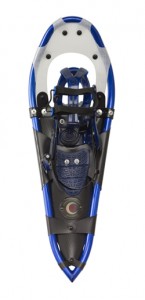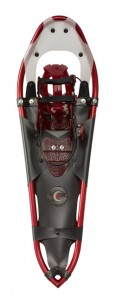Snowshoeing is fun and easy to do. Here’s how to select the right pair before you make some tracks.
Snowshoeing is a growing outdoor activity that not only offers excellent aerobic activity, but also allows you to enjoy the backcountry in unique way. The type and size of snowshoe is important to the type of conditions you’ll encounter, and your level of experience. Nevertheless, there are key factors into selecting the perfect set of snowshoes for your outdoor adventures.
Flotation
Flotation is a function of how the shoe allows you to evenly spread your body weight. Approximately 85 percent of the total flotation of the snowshoe occurs around the ball of the foot. Nevertheless, the length and width of the shoe determines its overall flotation in relationship with your body weight. So while an 80 lbs. kid can use a 20-inch snowshoe, a 200 lbs. adult may require a 30-inch design. The lengths range around 20-36 inches and you can aporoximate your weight if you want to avoid embarrassing yourself at the outdoor retailer.

The width of the show is typically proportional to the length so that the shoe remains balanced. For an average size and weight person, a 25 or 26 inch snowshoe will work well for an adult weighing 140-180 lbs. If you’re planning on using snowshoes for long backpacking trips into the backcountry, it’s important to also factor the weight of your pack as well. If you can’t make up your mind between lightweight versus length, keep in mind that it’s always better to sink in the snow a bit than to lift a heavy shoe for several miles.
Frame and Decking
The shoe’s frame and decking are also important to its overall flotation. A lightweight frame will make a huge difference after trekking several miles. Most frames have a teardrop shape that’s wider in front and narrower at the rear. It’s also important to know that women’s snowshoes are typically designed narrower at the rear, to accommodate for their natural stride. This helps keep the shoes from hitting each other as they walk. So don’t be tempted to get your wife or girlfriend a pair of men’s snowshoes for a killer deal at a rummage sale. Likewise, racing or fast trekking snowshoes are also narrower at the rear for people who want to run or walk quickly in the snow.
To keep the weight low, most modern shoe frames are made from aluminum tubing. You may find that some are offered in traditional wood designs, but most experienced snowshoe enthusiasts will recommend getting the lightest shoes possible. Some are made from a single piece of aluminum, but most are welded at the tail. The use of TIG welded (using tungsten inert gas) is best as it provides a stronger bond, but we’ve never seen a snowshoe come apart at the frame.
Originally, snowshoe decking was made from animal skin or leather. Now, decking is most often made from PVC or rubber coated nylon. In most designs, the flotation material is wrapped around the frame and riveted either into the frame or back into the flotation material itself. There’s not one advantage over the other, but some manufacturers will provide some kind of protection or add a cleat around the areas where the decking wraps around the frame, to prevent premature wear.
Binding

The snowshoe’s binding is probably one of the most important factors in how much you will enjoy snowshoeing. When you’re in the cold and have gloves on, the last thing you want to do is hassle with getting them on and off. So it’s best to avoid any type of binding that lace up or doesn’t have a quick-on or quick-release system. Try on several snowshoes at your favorite outdoor retailer and test out the bindings. Make sure you also try them on with the same hiking boots or shoes that you intend to wear. Check to see if the bindings hold your foot in place securely and that your foot doesn’t move from side to side or is pinched in any way. The bindings should also be easily adjustable while you’re wearing them and should also be easy to remove; a one-had operation would be optimal.
Fixed and Free Rotation Shoes
The rotation of the binding is purely up to the style and design of the manufacturer. A fixed rotation shoe will only drop several inches once you lift your foot off the ground. While it does kick up snow onto your back and neck, it’s preferred by people who race or like to hike quickly in harder packed snow. They also find it easier to back up and maneuver from side to side, making it a good choice for beginners as well.

A free rotation snowshoe will continually touch the ground as you lift your foot and is preferred for backcountry trips in deep snow. As the snow piles onto the rear of the shoe, the weight stays place and isn’t lifted with your foot. While the snowshoe drags on the ground, it also allows for the front toe to get a better bite on steep terrain.
Traction
Many snowshoes have crampon style traction systems to dig into the snow. Most have traction devices located at the ball of the foot and at the heel. Some provide three traction points and include a toe claw. This comes in very handy when climbing steep grades and for better all-round traction. Make sure that the traction claws are made from a rust-free material such as stainless steel. While titanium is lighter it’s also more expensive.
Be Prepared
No matter if it’s a 15-minute walk from your car or a 10 mile trek to set up a base camp, know the conditions you’re heading into and be prepared. Let people know when you’re leaving and when you will be returning. Bring enough food and water for your trip. Always use the layering method for your snowshoe trips. As you walk your body heats up you’ll tend to remove layers of clothing to keep cool. By knowing the basics of what makes up a snowshoe, you’ll make the best decision in your purchase and ultimately enjoy your snowshoe excursion even more.
By Dan Sanchez
Images provided by Crescent Moon Snowshoes www.crescentmoonsnowshoes.com
